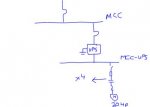I need to design a high reliability power back up for 4x 20HP motors (480v, 3PH) each for a critical application.
ATS with GEN is not an option. The client requested to design a UPS that can supply these motors and that can endure 4 hours during a power outage.
Anyone came across such an application? I have attached the the one-line for the system. But I need help with specifying such a UPS with backup batteries for this application.
Thank you for your input in advance.
ATS with GEN is not an option. The client requested to design a UPS that can supply these motors and that can endure 4 hours during a power outage.
Anyone came across such an application? I have attached the the one-line for the system. But I need help with specifying such a UPS with backup batteries for this application.
Thank you for your input in advance.

